Panda Restaurant Group Bundle
How Does Panda Restaurant Group Conquer the Fast-Casual World?
Panda Restaurant Group, the powerhouse behind Panda Express, isn't just another fast-food chain; it's a culinary empire. With over 2,500 locations globally, primarily in the United States, Panda Express has redefined American Chinese cuisine and captured the hearts (and appetites) of millions. But how does this family-owned enterprise maintain its dominance and consistently generate impressive profits in a competitive market?
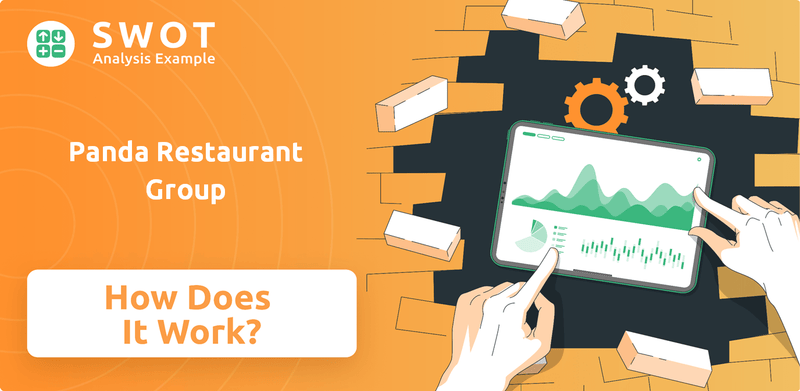
To truly understand Panda Restaurant Group's success, we'll dissect its operational model, explore its diverse revenue streams, and analyze its strategic initiatives. This deep dive will provide valuable insights for investors, industry observers, and anyone curious about the inner workings of this culinary giant. For a detailed look at its strengths and weaknesses, consider exploring the Panda Restaurant Group SWOT Analysis.
What Are the Key Operations Driving Panda Restaurant Group’s Success?
Panda Restaurant Group, primarily through its Panda Express restaurants, creates and delivers value by offering a unique blend of American Chinese cuisine. The company's core offerings, including popular dishes like Orange Chicken and Kung Pao Chicken, are designed to cater to a broad range of tastes. A key aspect of its value proposition is consistent quality and taste across its numerous locations.
The operational processes at Panda Express are streamlined to ensure efficiency and consistency. The company employs a vertically integrated model, which provides a strong advantage in supply chain management and consistency, allowing for rapid scaling without compromising quality. This approach helps in controlling food quality and costs, which in turn improves profit margins. Fresh ingredients, including hand-chopped and wok-tossed vegetables, are used to maintain high-quality standards.
Logistics and distribution networks are critical to supporting Panda's widespread operations. The company has focused on efficient utility connection services for its new restaurant builds, addressing potential delays caused by supply chain issues and communication gaps between contractors and utility providers. Panda Express also leverages digital platforms and technology, with digital sales projected to be over $90 billion in the restaurant industry in 2024. This includes digital ordering, delivery services, and mobile apps, which enhance customer convenience and engagement. The Panda Express app, for instance, received high marks in a 2024 study for its ordering performance.
The Panda Express menu features a variety of entrees, including Orange Chicken, Kung Pao Chicken, and Broccoli Beef, complemented by sides like Fried Rice and Chow Mein. The company emphasizes consistent quality and taste across all locations. The use of fresh ingredients, such as hand-chopped and wok-tossed vegetables, is a key element in maintaining its high-quality standards.
Panda Express utilizes a vertically integrated model to streamline operations and manage its supply chain effectively. This approach helps in controlling both food quality and costs. The company focuses on efficient utility connection services for new restaurant builds to avoid delays. This model supports rapid scaling and ensures consistency across its many locations.
Panda Express leverages digital platforms to enhance customer convenience and engagement. Digital sales in the restaurant industry are projected to exceed $90 billion in 2024. This includes digital ordering, delivery services, and a mobile app, which received high marks in a 2024 study for its ordering performance. These technologies contribute to reduced wait times and improved customer satisfaction.
Panda Restaurant Group continues to focus on expansion, supported by its efficient operational model and strong brand recognition. The company's ability to maintain consistent quality and adapt to changing consumer preferences is crucial for its growth. Understanding the Target Market of Panda Restaurant Group is vital to its expansion plans.
Panda Express's operational success relies on several key strategies, including a vertically integrated supply chain and a focus on digital innovation. These strategies contribute to the company's ability to maintain consistent quality and adapt to changing consumer preferences.
- Vertical Integration: Provides control over the supply chain, ensuring quality and cost management.
- Digital Platforms: Enhances customer convenience through online ordering and delivery services.
- Quality Control: Emphasizes fresh ingredients and consistent preparation methods across all locations.
- Expansion Plans: Focuses on strategic growth, supported by a strong operational model.
Panda Restaurant Group SWOT Analysis
- Complete SWOT Breakdown
- Fully Customizable
- Editable in Excel & Word
- Professional Formatting
- Investor-Ready Format
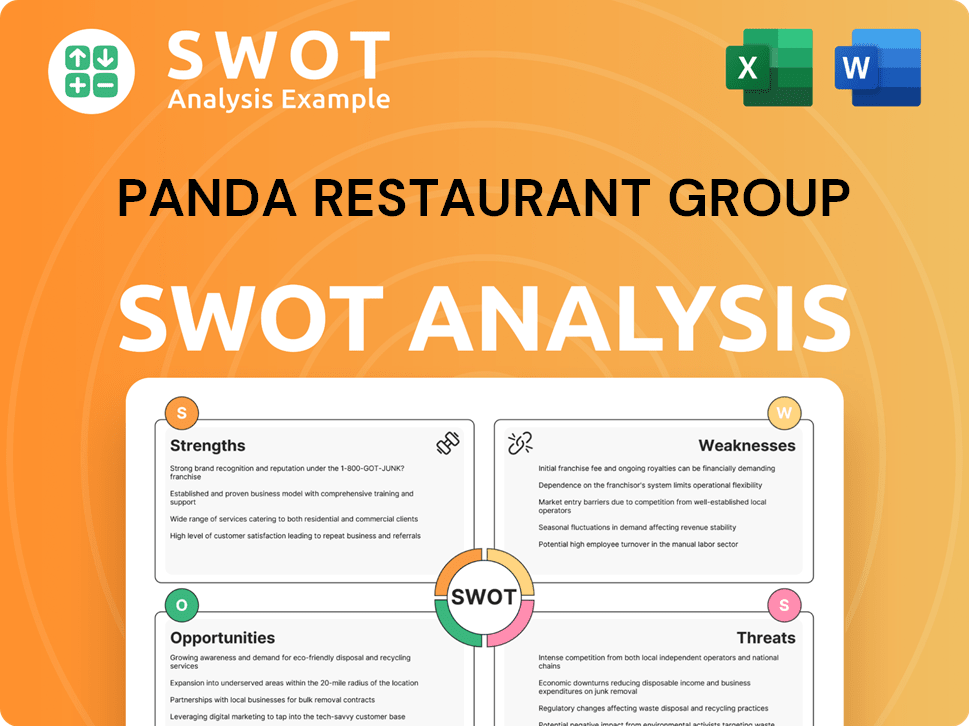
How Does Panda Restaurant Group Make Money?
The primary revenue stream for Panda Restaurant Group comes from direct sales at its Panda Express locations. As of late 2024, the company operated a vast network of both company-owned and franchised restaurants, contributing significantly to its financial performance. The strategic approach to revenue generation is multifaceted, involving various operational and marketing strategies.
Panda Express leverages several monetization strategies to boost its revenue. Menu innovation and diversification are key, with new items and limited-time offers designed to keep customers engaged and drive repeat business. Digital ordering and drive-thru services are increasingly important revenue channels, reflecting consumer demand for convenience.
Panda Group Company also focuses on customer loyalty programs and expansion into non-traditional venues to diversify its revenue streams and enhance brand loyalty. This multi-pronged approach allows Panda Restaurant Group to maximize its market presence and financial performance.
Panda Express generates revenue primarily through direct sales from its restaurants, both company-owned and franchised. As of December 28, 2024, the company had 2,329 owned and operated restaurants, along with 173 franchised locations in the U.S. and 97 international franchised restaurants. Systemwide sales reached approximately $4.5 billion in 2024.
- Menu Innovation and Diversification: Panda Express frequently introduces new menu items and limited-time offers to attract and retain customers. The Hot Orange Chicken launch in May-June 2024 increased same-store sales by 5% in 2024.
- Digital Ordering and Drive-Thru Services: Digital sales are a growing revenue channel, with strategic investments in these areas.
- Customer Loyalty Programs: The Panda Rewards program, launched in May 2023, offers points for every dollar spent, encouraging repeat visits.
- Expansion into Non-Traditional Venues: Exploring opportunities in airports, universities, and military bases to diversify revenue streams. For additional information on the competitive landscape, you can read about the Competitors Landscape of Panda Restaurant Group.
Panda Restaurant Group PESTLE Analysis
- Covers All 6 PESTLE Categories
- No Research Needed – Save Hours of Work
- Built by Experts, Trusted by Consultants
- Instant Download, Ready to Use
- 100% Editable, Fully Customizable
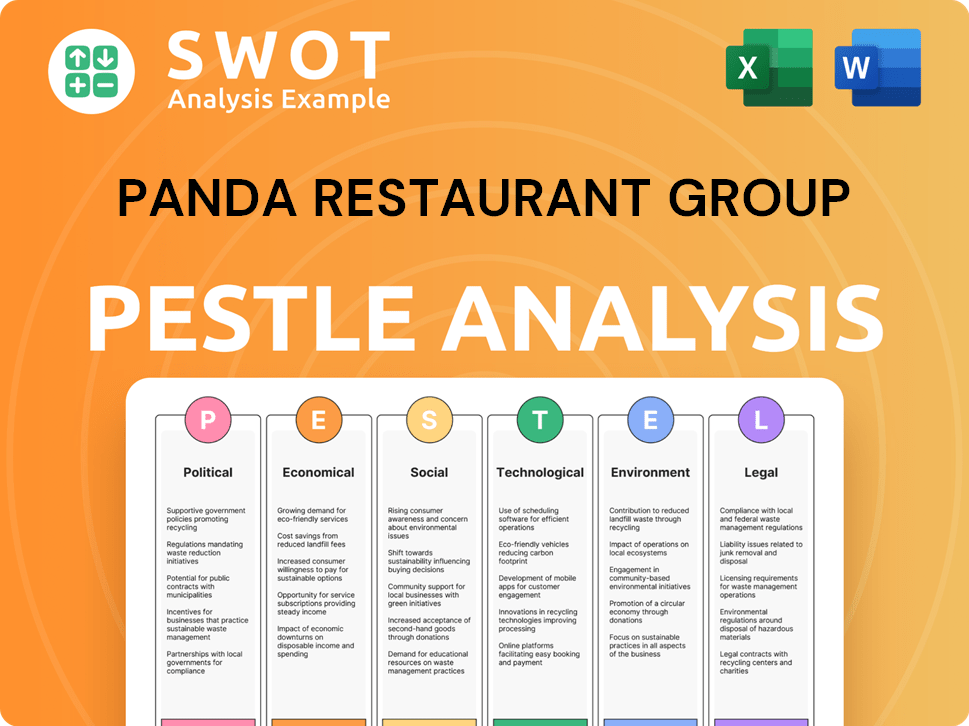
Which Strategic Decisions Have Shaped Panda Restaurant Group’s Business Model?
The journey of the Panda Restaurant Group, particularly Panda Express, has been marked by significant milestones and strategic moves that have solidified its market position. Founded in 1983, the company has grown from a single restaurant to over 2,500 locations globally by 2024. This expansion reflects a robust business model and a keen understanding of consumer preferences, making it a prominent player in the fast-food industry.
A pivotal strategic move has been its continuous expansion, with plans to open over 130 new restaurants in 2025, marking one of its largest annual expansions to date. This growth includes a focus on high-growth areas like Texas and Florida. These expansions are supported by a vertically integrated supply chain and efficient operational strategies that enhance profit margins and allow for rapid growth. The company's ability to adapt to market demands, such as introducing new dishes and limited-time offers, further enhances its competitive edge.
Panda Express has consistently adapted to market demands and consumer preferences. One notable strategic move is the continuous update and innovation of its menu, introducing new and exciting dishes and limited-time offers. For example, the launch of Hot Orange Chicken in 2024 demonstrated its embrace of bolder flavor profiles and trending ingredients. To understand their approach, you can read about the Marketing Strategy of Panda Restaurant Group.
Founded in 1983, Panda Express has expanded to over 2,500 locations globally by 2024. This rapid growth signifies a strong business model and effective market strategies.
Continuous menu innovation, including the introduction of new dishes like Hot Orange Chicken in 2024, demonstrates adaptability. Expansion plans include opening over 130 new restaurants in 2025, focusing on high-growth areas.
Strong brand recognition and a proven business model contribute to Panda Express's success. Digital channels contribute 25% to revenue as of 2024, and smart building technology optimizes energy consumption.
The company faced a data breach in March 2024, compromising personal information. Supply chain issues and menu innovation challenges, with about 15% of new menu items in 2024 not meeting sales targets, also pose hurdles.
Panda Restaurant Group's competitive edge is multifaceted, including strong brand recognition and a significant market presence. A vertically integrated supply chain enhances profit margins and cash flow, supporting rapid expansion. The company's commitment to employee welfare and digital transformation further boosts its position.
- Strong Brand Recognition: A familiar and trusted name in the fast-food industry.
- Operational Efficiency: A proven business model and vertically integrated supply chain.
- Digital Transformation: Digital channels contributed 25% to revenue in 2024.
- Employee Welfare: Commitment to employee training and development.
Panda Restaurant Group Business Model Canvas
- Complete 9-Block Business Model Canvas
- Effortlessly Communicate Your Business Strategy
- Investor-Ready BMC Format
- 100% Editable and Customizable
- Clear and Structured Layout
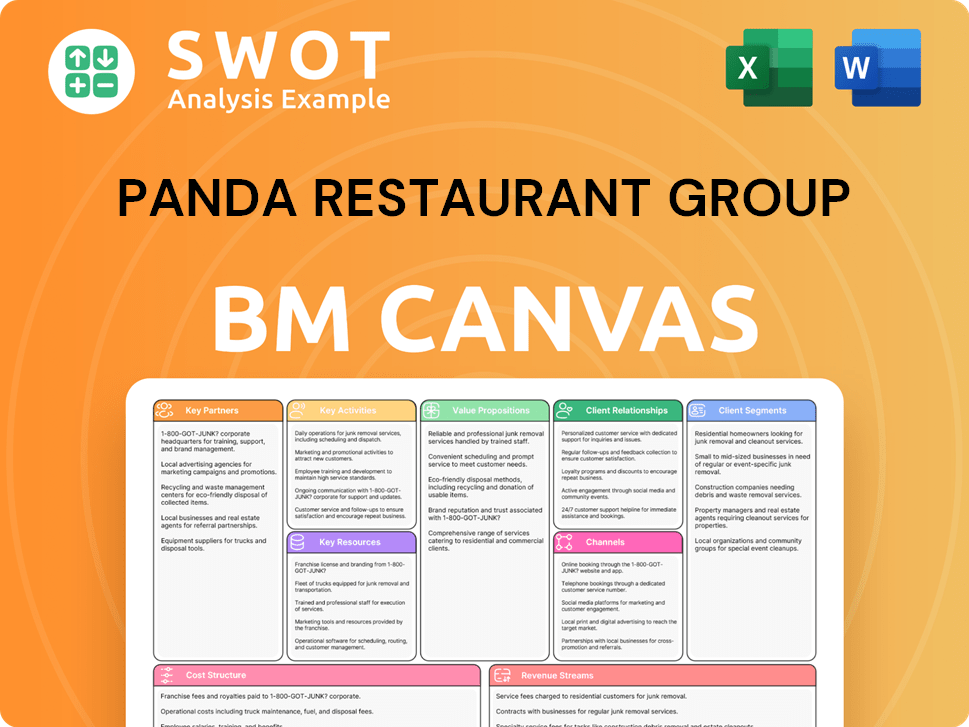
How Is Panda Restaurant Group Positioning Itself for Continued Success?
Panda Restaurant Group, with its flagship brand Panda Express, holds a strong position in the fast-casual dining industry. By 2024, the company had over 2,500 locations globally, making it the largest Asian-segment restaurant chain in the United States. This success is built on strong brand recognition and a menu tailored to American tastes.
Despite its market strength, Panda Restaurant Group faces various challenges. Intense competition within the fast-food sector and changing consumer preferences, particularly the growing demand for healthier options, pose ongoing difficulties. The company also deals with operational pressures like high real estate costs, increasing labor expenses, and supply chain disruptions.
Panda Express has a significant market share due to its strong brand and customer loyalty. Its ability to adapt its menu to suit American preferences has been a key factor. The company's strategic expansion into different venue types further strengthens its market position.
The company faces risks from intense competition and changing consumer demands. Rising costs, including labor and food, impact profitability. Cybersecurity threats, like the March 2024 data breach, also pose significant risks.
Panda Restaurant Group plans for sustained growth through strategic initiatives. The company aims for a 5% annual growth in locations. Menu diversification and community involvement are also key elements of their future strategy.
Panda Express is investing in digital ordering, rewards programs, and efficient kitchen layouts. They are also focusing on sustainable operations and menu diversification. Community involvement through the Panda Cares Foundation enhances their brand image.
Panda Restaurant Group plans to open over 130 new restaurants in 2025, indicating a strong focus on expansion. The company is also investing in technology to improve customer experience and operational efficiency. This strategic focus on growth is detailed in a recent article about the Growth Strategy of Panda Restaurant Group.
- Digital innovation to improve ordering and rewards.
- Menu diversification to cater to a wider audience, including plant-based options.
- Commitment to sustainable practices and community involvement.
- Focus on efficient kitchen layouts for faster service.
Panda Restaurant Group Porter's Five Forces Analysis
- Covers All 5 Competitive Forces in Detail
- Structured for Consultants, Students, and Founders
- 100% Editable in Microsoft Word & Excel
- Instant Digital Download – Use Immediately
- Compatible with Mac & PC – Fully Unlocked
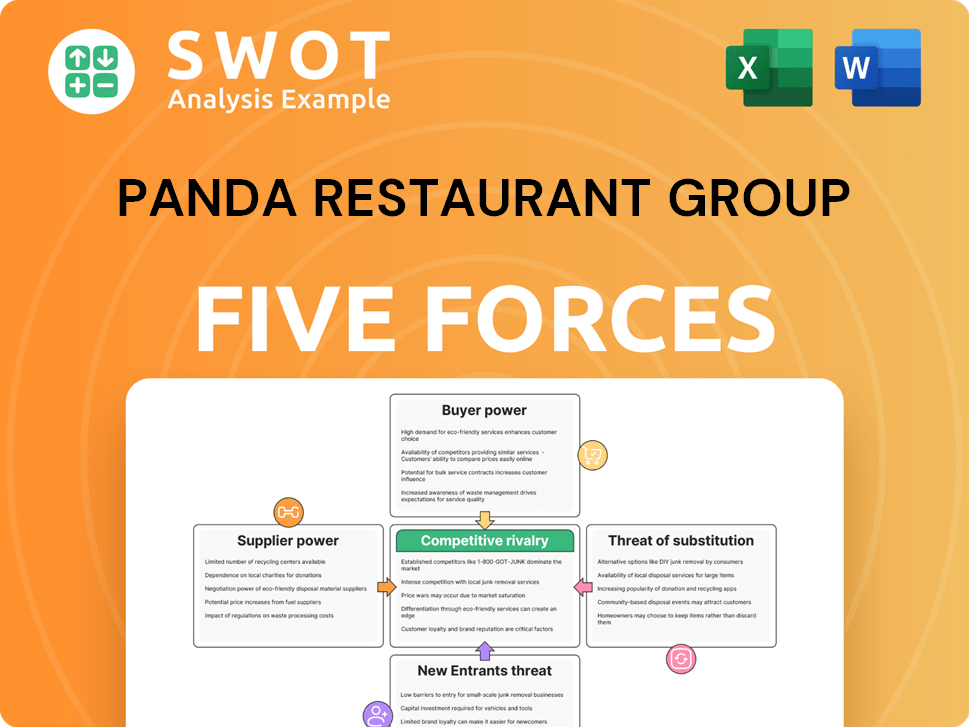
Related Blogs
- What are Mission Vision & Core Values of Panda Restaurant Group Company?
- What is Competitive Landscape of Panda Restaurant Group Company?
- What is Growth Strategy and Future Prospects of Panda Restaurant Group Company?
- What is Sales and Marketing Strategy of Panda Restaurant Group Company?
- What is Brief History of Panda Restaurant Group Company?
- Who Owns Panda Restaurant Group Company?
- What is Customer Demographics and Target Market of Panda Restaurant Group Company?
Disclaimer
All information, articles, and product details provided on this website are for general informational and educational purposes only. We do not claim any ownership over, nor do we intend to infringe upon, any trademarks, copyrights, logos, brand names, or other intellectual property mentioned or depicted on this site. Such intellectual property remains the property of its respective owners, and any references here are made solely for identification or informational purposes, without implying any affiliation, endorsement, or partnership.
We make no representations or warranties, express or implied, regarding the accuracy, completeness, or suitability of any content or products presented. Nothing on this website should be construed as legal, tax, investment, financial, medical, or other professional advice. In addition, no part of this site—including articles or product references—constitutes a solicitation, recommendation, endorsement, advertisement, or offer to buy or sell any securities, franchises, or other financial instruments, particularly in jurisdictions where such activity would be unlawful.
All content is of a general nature and may not address the specific circumstances of any individual or entity. It is not a substitute for professional advice or services. Any actions you take based on the information provided here are strictly at your own risk. You accept full responsibility for any decisions or outcomes arising from your use of this website and agree to release us from any liability in connection with your use of, or reliance upon, the content or products found herein.